Structure of the s5a:k48-linked diubiquitin complex and its interactions with rpn13
- PMID: 19683493
- PMCID: PMC2748877
- DOI: 10.1016/j.molcel.2009.06.010
Structure of the s5a:k48-linked diubiquitin complex and its interactions with rpn13
Abstract
Degradation by the proteasome typically requires substrate ubiquitination. Two ubiquitin receptors exist in the proteasome, S5a/Rpn10 and Rpn13. Whereas Rpn13 has only one ubiquitin-binding surface, S5a binds ubiquitin with two independent ubiquitin-interacting motifs (UIMs). Here, we use nuclear magnetic resonance (NMR) and analytical ultracentrifugation to define at atomic level resolution how S5a binds K48-linked diubiquitin, in which K48 of one ubiquitin subunit (the "proximal" one) is covalently bonded to G76 of the other (the "distal" subunit). We demonstrate that S5a's UIMs bind the two subunits simultaneously with a preference for UIM2 binding to the proximal subunit while UIM1 binds to the distal one. In addition, NMR experiments reveal that Rpn13 and S5a bind K48-linked diubiquitin simultaneously with subunit specificity, and a model structure of S5a and Rpn13 bound to K48-linked polyubiquitin is provided. Altogether, our data demonstrate that S5a is highly adaptive and cooperative toward binding ubiquitin chains.
Figures
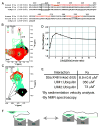
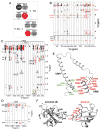
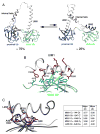
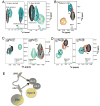
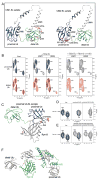
Similar articles
-
Ubiquitin docking at the proteasome through a novel pleckstrin-homology domain interaction.Nature. 2008 May 22;453(7194):548-52. doi: 10.1038/nature06924. Nature. 2008. PMID: 18497827 Free PMC article.
-
Proteasome subunit Rpn13 is a novel ubiquitin receptor.Nature. 2008 May 22;453(7194):481-8. doi: 10.1038/nature06926. Nature. 2008. PMID: 18497817 Free PMC article.
-
An Extended Conformation for K48 Ubiquitin Chains Revealed by the hRpn2:Rpn13:K48-Diubiquitin Structure.Structure. 2020 May 5;28(5):495-506.e3. doi: 10.1016/j.str.2020.02.007. Epub 2020 Mar 10. Structure. 2020. PMID: 32160516 Free PMC article.
-
The chemical biology of ubiquitin.Biochim Biophys Acta Gen Subj. 2022 Mar;1866(3):130079. doi: 10.1016/j.bbagen.2021.130079. Epub 2021 Dec 29. Biochim Biophys Acta Gen Subj. 2022. PMID: 34971772 Free PMC article. Review.
-
Ubiquitin and its binding domains.Front Biosci (Landmark Ed). 2012 Jun 1;17(6):2140-57. doi: 10.2741/4042. Front Biosci (Landmark Ed). 2012. PMID: 22652769 Free PMC article. Review.
Cited by
-
Structural basis for dynamic regulation of the human 26S proteasome.Proc Natl Acad Sci U S A. 2016 Nov 15;113(46):12991-12996. doi: 10.1073/pnas.1614614113. Epub 2016 Oct 21. Proc Natl Acad Sci U S A. 2016. PMID: 27791164 Free PMC article.
-
Structure characterization of the 26S proteasome.Biochim Biophys Acta. 2011 Feb;1809(2):67-79. doi: 10.1016/j.bbagrm.2010.08.008. Epub 2010 Aug 26. Biochim Biophys Acta. 2011. PMID: 20800708 Free PMC article. Review.
-
A new crystal form of Lys48-linked diubiquitin.Acta Crystallogr Sect F Struct Biol Cryst Commun. 2010 Sep 1;66(Pt 9):994-8. doi: 10.1107/S1744309110027600. Epub 2010 Aug 21. Acta Crystallogr Sect F Struct Biol Cryst Commun. 2010. PMID: 20823512 Free PMC article.
-
Small-Molecule Inhibitors of the Proteasome's Regulatory Particle.Chembiochem. 2019 Jul 15;20(14):1739-1753. doi: 10.1002/cbic.201900017. Epub 2019 May 24. Chembiochem. 2019. PMID: 30740849 Free PMC article. Review.
-
Structure of the Rpn13-Rpn2 complex provides insights for Rpn13 and Uch37 as anticancer targets.Nat Commun. 2017 Jun 9;8:15540. doi: 10.1038/ncomms15540. Nat Commun. 2017. PMID: 28598414 Free PMC article.
References
-
- Bertolaet BL, Clarke DJ, Wolff M, Watson MH, Henze M, Divita G, Reed SI. UBA domains of DNA damage-inducible proteins interact with ubiquitin. Nat Struct Biol. 2001;8:417–422. - PubMed
-
- Ciechanover A. The ubiquitin-proteasome proteolytic pathway. Cell. 1994;79:13–21. - PubMed
-
- Ciechanover A, Finley D, Varshavsky A. Ubiquitin dependence of selective protein degradation demonstrated in the mammalian cell cycle mutant ts85. Cell. 1984;37:57–66. - PubMed
-
- Deveraux Q, Ustrell V, Pickart C, Rechsteiner M. A 26 S protease subunit that binds ubiquitin conjugates. J Biol Chem. 1994;269:7059–7061. - PubMed
-
- Elsasser S, Gali RR, Schwickart M, Larsen CN, Leggett DS, Muller B, Feng MT, Tubing F, Dittmar GA, Finley D. Proteasome subunit Rpn1 binds ubiquitin-like protein domains. Nat Cell Biol. 2002;4:725–730. - PubMed
Publication types
MeSH terms
Substances
Associated data
- Actions
- Actions
Grants and funding
LinkOut - more resources
Full Text Sources
Other Literature Sources
Molecular Biology Databases

